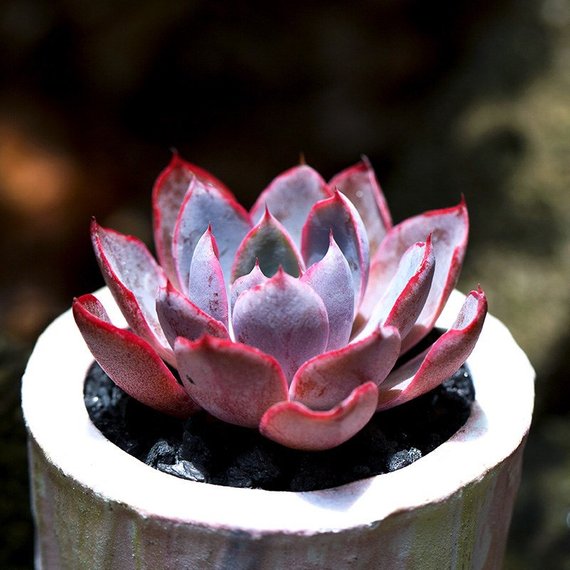The Succulent Echeveria hera belongs to the Sedum genus in the Crassulaceae family, and it is a popular variety in the Winter Cloud series. Once introduced, it has been loved by many flower enthusiasts. It is a hybrid of the Sunset and Daiwa Jin varieties. The leaves of Echeveria hera are slender and large, with a covering of white frost on top. When not mature, the leaves are green, but with a slight temperature difference, they quickly turn a deep red, with clear and bright veins. It maintains its compactness throughout the year, resembling an ever-burning flame, full of vitality. Hence, some people refer to it as the "Blood Droplet" in the world of succulents.
Flower enthusiasts who have raised Echeveria hera have given it high praise, especially during the spring and autumn seasons. Placing Echeveria hera directly outdoors on sunny days during these seasons results in its leaves appearing compact and plump. After a light rain, dewdrops cling to its leaves, adding to its charm. It has particularly high ornamental value.
Characteristic 1: Rooting in granular soil
Although Echeveria hera can develop into an old stump shape, its root system is not well-developed. Therefore, when preparing the soil, it is essential to ensure good soil ventilation. The proportion of granular soil in the mixture should be at least 40%. Dry roots and moist leaves is a basic rule of nutrition for Echeveria hera, which all novice flower enthusiasts must remember well.
For newly acquired Echeveria hera, root pruning is necessary after acquisition. Trim off the withered capillaries, leaving only the robust main roots. Soak them in a fungicide solution and let them air dry in a ventilated area. Then, mix the prepared leaf mold and granular soil, water once, and bury the trimmed Echeveria hera in the soil. Place it in a shaded area, spray water in the morning and evening, and it will generally adapt to the new potting environment within 1 to 2 weeks.
When preparing the soil, use leaf mold mixed with granular soil in a ratio of 6:4. The proportion of granular soil can be increased appropriately. The watering frequency should not be too rapid—water only when the soil is dry.
Characteristic 2: Leaf growth in high humidity
To make Echeveria hera's leaves plumper and more resilient, the growth environment must be warm and humid. However, because Echeveria hera's leaves are protected by a white powder, direct spraying of water mist should be avoided during maintenance. Increasing humidity is simple—use granular soil when preparing the soil and add a layer of gravel on the soil surface. Spraying water mist around the pot and on the surface in the morning and evening will gradually increase the humidity in Echeveria hera's microenvironment.
The water mist will slowly evaporate, naturally increasing the humidity around Echeveria hera. However, when spraying water mist, it is essential to choose the morning or evening when the temperature is more suitable. After the water evaporates, Echeveria hera can absorb it, avoiding waterlogging and black rot. Additionally, insecticide can be added to the water mist to prevent pests. When spraying, thoroughly dilute the insecticide and evenly spray it over Echeveria hera's leaves. Then, spray some on the back of the leaves and the base. Excess insecticide can be poured onto the roots. After spraying, provide artificial ventilation to quickly evaporate the water mist.
Characteristic 3: Coloration with significant temperature differences
To raise Echeveria hera well and promote rapid coloration, a significant temperature difference must be artificially created. During the day, place Echeveria hera in an outdoor location for photosynthesis. Then, move it to a cooler place at night or sprinkle water around it to dissipate heat, aiming for a temperature difference of at least 10°C.
In this environment with significant temperature differences, the chlorophyll synthesized by Echeveria hera decreases, while nutrients such as anthocyanins and carotenes increase. As a result, the leaves quickly turn red, with clearer veins. Coupled with the plump and compact leaves, the ornamental value is greatly enhanced.
